By Marie Louise (Mickey) Wesley Swinford as told to Karen Schansman
Note: This story was originally published in the historical book The Way We Were – Recollections of South Walton Pioneers; published in 1996 by South Walton Three Arts Alliance. Republished with permission. You may find a copy of the book that includes many short stories about our area’s colorful history at the Coastal Branch Library. You may also find its follow up book Of Days Gone By – Reflections of South Walton County, Florida published in 1999. The Wesley house is located at Eden Gardens State Park in Point Washington.
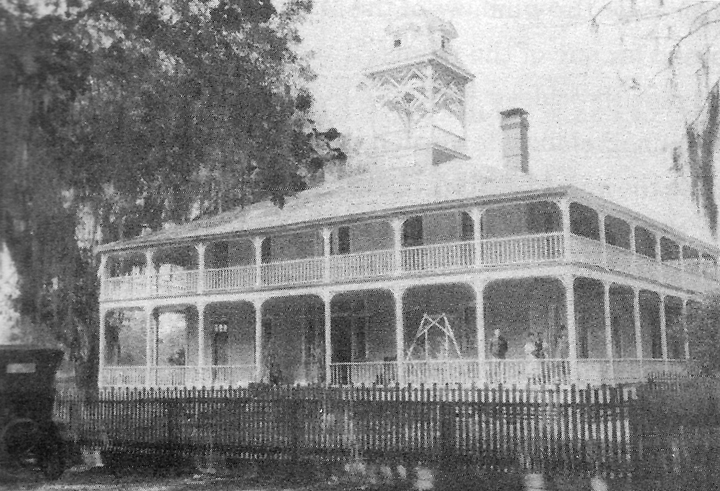
William Henry Wesley, my father, was born in Brunswick, Georgia on November 30, 1865. He came to Point Washington with his father, John Wesley, a Methodist minister, sometime around 1890. My mother, Katie Marie Strickland Wesley, was born in Point Washington on August 30, 1875. The daughter of Captain Simeon Strickland and Louise Florence Wise Strickland, she was known as Miss Katie to her friends.
My father taught school in Point Washington and there met my mother, who was one of his students. My mother was a small person – not more than five feet tall and weighing less than 100 pounds – but she was a strong, hardworking woman with a strong will. They were married in 1893. Over the years, Mamma and Papa had nine children, including a set of twin boys. I was next to the youngest, born on July 13, 1910. I am the last surviving child.
Our family home in Point Washington was built sometime between 1895 and 1897. The 5500 square-foot, two-story home had a central hallway and stairs surrounded by four large rooms complete with fireplace on each floor.
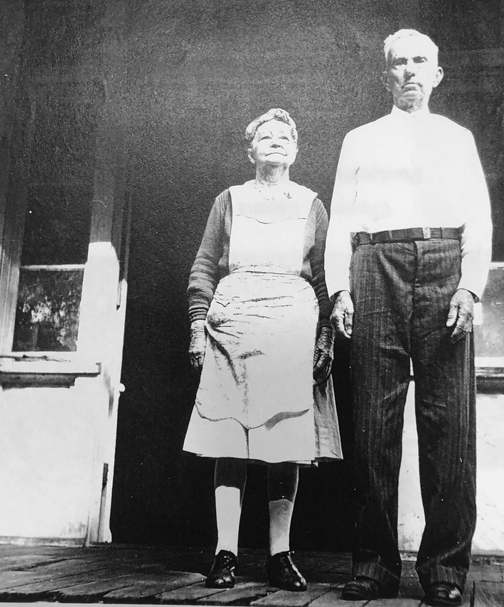
We had a windmill that pumped water for the house. Later, we were hooked into a water line from an artesian well. Until the government power reached the area, our electricity was provided by a Delco generator. We had a Satsuma orange grove in the yard where the reflection pool is now. Fig trees were on each side of the kitchen. West of the home, near the head of Tucker Bayou, we had a ten-acre lot which was used to grow all kinds of vegetables. My younger brother Bill, my twin brothers, Arthur and Edgar, and I had lots of fun digging potatoes and taking them to the branch to wash them off. I think we poured more water on each other than we did on the potatoes.
I think all of the family were members of the Point Washington Methodist Church. I can recall that my mother played the organ and did a lot of singing too. I’ve heard it told that one evening when Ollie Thompson from DeFuniak Springs was singing in front of the congregation, Miss Katie started to sing along to help him. Ollie stopped singing and said, “Katie, this is supposed to be a solo.”
Wash days were quite a chore, as I recall. We’d collect water in big tubs, scrub the clothes on washboards, and then boil them for a while in a big iron pot. My main job was to replenish the fire around the pot with lightered wood. Then, of course, the cleaned and scrubbed clothes had to be hung on a line to dry.
Miss Katie was a great cook. My husband, Bob, fondly remembers the black eyed peas, collard greens, and hoe cakes she used to serve. By today’s standards I don’t guess you could consider some of her cooking healthy, but it sure was tasty. In the winter, Papa would butcher a cow or a pig for fresh meat. We had a smokehouse out back to cure the hams. Mamma and Papa both loved chitlings. After the butchering, Mamma would take the entrails down to the bayou and wash them thoroughly before cooking them. I hated the smell and taste of chitlings. We ate a lot of fish and hushpuppies, too. Miss Katie’s favorite pastime was fishing and she managed to keep us well supplied.
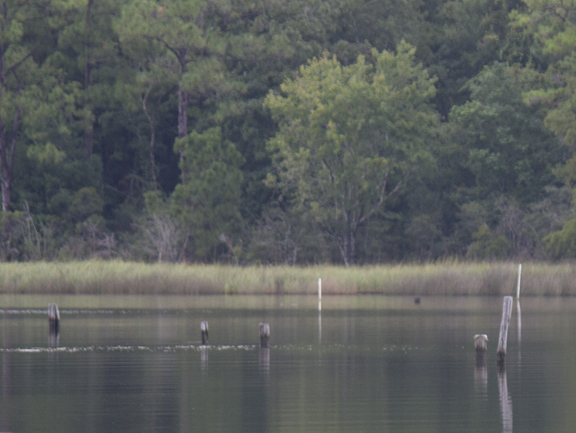
During the early years of his marriage, my father became involved with Captain Strickland in the sawmill business. After several years, I’m not sure just when, Papa built a mill of his own. The mill was located on the shore of the bayou, north of the house about where the picnic area and dock are located today. A dry kiln and planer mill were located nearby. Finished lumber, awaiting shipment by barge to Pensacola, was stacked on wharves in the bayou. The remnants of some of the piling for the wharves are still visible today.
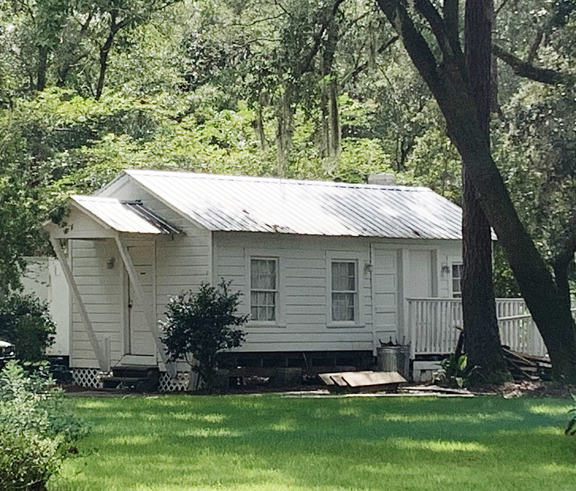
The sawmill business was a rough and ready one and Papa had a lot of enemies. They managed to burn the mill several times. I remember the last time it was burned. My father was away and Mamma and I went down to check on the mill. We found that someone had tried to start a fire, but we apparently had scared them away. Later that night they came back – this time succeeding. The fire destroyed everything – even the planer mill and a lot of finished lumber.
During the early years, I’ve been told, my father liked his spirits. He and his half-brother, Marvin, frequently drank corn mash whiskey. Sometimes he would go out carousing with his buddies and, after having too much to drink, he’d climb into his buggy and let his horse bring him home. Mamma didn’t like that a bit. I recall one time Mamma was giving me a bath in a tub in front of the fireplace. We heard a scuffling noise in the hall followed by Uncle Marvin’s voice slurring, “Katie, I’m bringing Willie home.” Needless to say, Miss Katie read the riot act to both of them.
Mabel, my sister and eldest child of the family, liked to go dancing at Grayton Beach, but Papa didn’t approve. He forbid her to go, but Mabel was stubborn and determined. Papa told her that if she went, she could not come back home. That’s when Mamma intervened and said, “If you send her away, then I’ll go away too.” I understand he relented after that.
After attending Florida State College for Women, now Florida State University, and receiving a B.S. degree in nursing, I met my husband, Kenneth Roberts (Bob) Swinford. We were married in the parlor of the Wesley home on December 19, 1938. Bob and I have spent many happy hours at the home and are pleased that Miss Maxon fixed it up and donated it to the State of Florida so that others many enjoy it also.
Miss Maxon’s Estate
By Karen Schansman
After sitting abandoned for ten years, the Wesley home was revitalized in 1963 when it was purchased for $12,500 by Miss Lois Maxon, a former reporter for the New York World-Telegram and heir to the industrial manufacturing fortune of Maxon Corp. of Muncie, Indiana. Miss Maxon put a million dollars into the property, renovating the home to a splendor it had never seen before. Two original chimneys and a partition on the first story were removed to make the large music room, where she gave local children free piano lessons. Kitchen and dining facilities were created at the rear of the house by enclosing the porches of both stories.
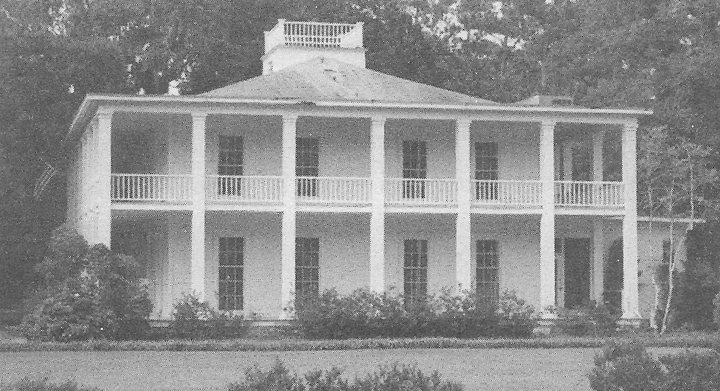
Family heirlooms, along with numerous antiques purchased on her many trips to Europe, were added to grace the home. Point Washington resident, Lucille Beck, sawed cornices or the windows of the Maxon home and was commissioned to crochet a bedspread for one of the rooms. “I reckon it’s still on the sleigh bed over there,” Lucille says with pride.
Miss Maxon had elaborate gardens planted to accent the moss-draped live oaks that dominate the lawn. Lucille’s husband, Chris, worked in the gardens planting azaleas, “On the south side of the house she had the most beautiful rose garden,” Lorraine Barrett Morgan recalls. “My mother-in-law, Violet Morgan, was her housekeeper. Miss Maxon always had bouquets of roses in every room in her home and she sent Violet home with roses all the time.”
After a decline in her health, Miss Maxon moved to Pensacola. She donated the home and gardens to the State of Florida in loving memory of her parents in 1968.
The Wesley House at Eden is decorated each Christmas season by local organizations:
Directions
Eden Gardens State Park is located in Point Washington, off U.S. 98 on C.R. 395.
For more information, call (850) 267-8320.
181 Eden Garden Road, Point Washington, Fl. 32459 ::MAP::
The park’s website is
https://www.floridastateparks.org/park/Eden-Gardens
Park Fees
$4.00 per vehicle. Please use the honor box to pay fees. Correct change is required. Limit 8 people per vehicle.
$2.00 Pedestrians, bicyclists, extra passengers, passengers in vehicle with holder of Annual Individual Entrance Pass.
House Tours:
$4.00 per adult.
$2.00 per child.
Resources for this story including Bob Swinford; Lucille and Chris Beck; Merry Boyette, tour guide at Eden Gardens State Park; Eden State Gardens…. More of the REAL Florida, Florida Department of Natural Resources publication; “History of Eden State Park” article from the DeFuniak Springs Herald-Breeze, June 14, 1979; “Eden Lies Just Up The Road” article from Panama City News-Herald, July 12, 1981.

